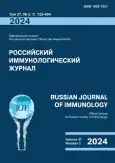Аллергия у ВИЧ-инфицированных пациентов (на примере клинического наблюдения)
- Авторы: Иванова О.Н.1, Иванова И.С.1
-
Учреждения:
- Медицинский институт ФГАОУ ВО «Северо-Восточный федеральный университет»
- Выпуск: Том 27, № 2 (2024)
- Страницы: 227-230
- Раздел: КРАТКИЕ СООБЩЕНИЯ
- URL: https://journals.rcsi.science/1028-7221/article/view/263680
- DOI: https://doi.org/10.46235/1028-7221-16601-AIH
- ID: 263680
Цитировать
Полный текст
Аннотация
Статья посвящена изучению причин формирования аллергических заболеваний у пациентов с ВИЧ на примере клинического случая. Пациентка Ц., 35 лет, находилась на диспансерном наблюдении в клинике «Виктори» с 2013 года по 2015 год с проявлениями кожной аллергии. В течение последующих четырех лет пациентка получала терапию при обострении атопического дерматита, придерживалась диеты с исключением молочных продуктов и говядины. Состояние пациентки можно было оценить как удовлетворительное, рецидивы атопического дерматита отмечались 2 раза после нарушений диеты. В 2017 году после незащищенного контакта пациентка заметила: слабость, снижение веса, сухость кожи и увеличение периферических лимфоузлов. В июне 2017 года пациентка обратилась к участковому педиатру, который выписал направление на общий анализ крови и мочи, анализ крови на СПИД и гепатиты. В результате обследования у пациентки выявлена ВИЧ-инфекция. Больная была обследована и пролечена в СПИД-центре города Якутска. С августа 2017 года пациентку беспокоит заложенность носа, чихание, слезотечение, головные боли.
В начале сентября 2017 года пациентка обратилась к аллергологу-иммунологу. Было проведено обследование: взят анализ крови на аллергоскрин панель № 1 и иммунограмму, риноцитограмму.
Были получены следующие результаты: по аллергоскрину № 1 – аллергия на березу 3.0, молоко 3.2, пшеничную муку 2.8. Данные риноцитограммы от 28.09.2017: нейтрофилы 67 в п/зр, эозинофилы 10 в п/зр.
У людей, инфицированных вирусом иммунодефицита человека (ВИЧ), наблюдается высокий уровень аллергических состояний, включая аллергический ринит (сенную лихорадку), лекарственную аллергию и астму. Вирус ВИЧ заражает и разрушает CD4+Т-клетки, тип белых кровяных телец. Это приводит к изменению иммунной функции, что способствует развитию аллергии, инфекций, рака и других иммунных проблем. У пациентки с ВИЧ-инфекцией, после выявления патологии наблюдается формирование и трансформация аллергических заболеваний. Формирование аллергопатологии у пациентов с ВИЧ связано с сниженным уровнем клеток CD4+, что является одним из факторов, способствующим развитию трансформации аллергии. Лечение аллергических заболеваний: бронхиальной астмы, атопического дерматита, аллергического ринита и аллергической крапивницы у пациентов с ВИЧ такое же, как у пациентов, не инфицированных ВИЧ. Следует избегать перорального приема глюкокортикостероидов ввиду иммунодепрессивного воздействия данной группы препаратов.
Полный текст
Открыть статью на сайте журналаОб авторах
О. Н. Иванова
Медицинский институт ФГАОУ ВО «Северо-Восточный федеральный университет»
Email: olgadoctor@list.ru
д.м.н., член РАЕН, Союза педиатров России, Российской ассоциации аллергологов и клинических иммунологов, главный внештатный аллерголог-иммунолог Министерства здравоохранения Республики Саха (Якутия), профессор кафедры педиатрии и детской хирургии
Россия, ЯкутскИ. С. Иванова
Медицинский институт ФГАОУ ВО «Северо-Восточный федеральный университет»
Автор, ответственный за переписку.
Email: olgadoctor@list.ru
студентка
Россия, ЯкутскСписок литературы
- Нора С.А., Архипов Г.С., Архипова Е.И., Никитина Н.Н. Иммуногенетические особенности коморбидности ВИЧ-инфекции и аллергии // Казанский медицинский журнал, 2021. Т. 102, № 6. С. 887-892. [Nora S.A., Arkhipov G.S., Arkhipova E.I., Nikitina N.N. Immunogenetic features of HIV infection and allergy comorbidity. Kazanskiy meditsinskiy zhurnal = Kazan Medical Journal, 2021, Vol. 102, no. 6, pp. 887-892. (In Russ.)]
- Нора С.А., Архипов Г.С., Архипова Е.И. Изучение показателей иммунного статуса у ВИЧ-инфицированных пациентов с сочетанной аллергической патологией // Казанский медицинский журнал, 2021. Т. 102, № 6. С. 821-826. [Nora S.A., Arkhipov G.S., Arkhipova E.I., The study of immune status indicators in HIV-infected patients with combined allergic pathology. Kazanskiy meditsinskiy zhurnal = Kazan Medical Journal, 2021, Vol. 102, no. 6, pp. 821-826. (In Russ.)]
- Нора С.А., Архипов Г.С. Диагностика аллергических заболеваний у ВИЧ-инфицированных пациентов с применением компьютерных технологий // ВИЧ-инфекция и иммуносупрессии, 2022. Т. 14, № 1. С. 121-127. [Nora S.A., Arkhipov G.S. Diagnosis of allergic diseases in HIV-infected patients using computer technology. VICh-infektsiya i immunosupressii = HIV Infection and Immunosuppression. 2022, Vol. 14, no. 1, pp. 121-127. (In Russ.)]
- Семенова Н.С., Шабанова А.В., Нора С.А., Трофимова Т.С. ВИЧ-инфекция и аллергозы: ретроспективный анализ коморбидности на территории Новгородской области // Вестник Новгородского государственного университета, 2022. № 1 (126). С. 34-37. [Semenova N.S., Shabanova A.V., Nora S.A., Trofimova T.S. HIV infection and allergoses: a retrospective analysis of comorbidity in the Novgorod region. Vestnik Novgorodskogo gosudarstvennogo universiteta = Bulletin of the Novgorod State University, 2022, no. 1 (126), pp. 34-37. (In Russ.)]
- European AIDS Clinical Society Guidelines. Version 8.2 2017. 96 p. (http://www.who.int/hiv)
- Guidelines on when to start antiretroviral therapy and pre-exposure prophylaxis for HIV. WHO, September 2015. Available at on the WHO. doi: 10.1093/ofid/ofv126 (https://www.researchgate.net/publication/281619496).
Дополнительные файлы







